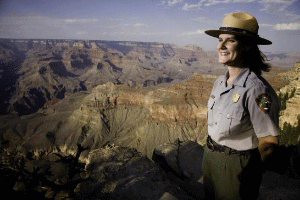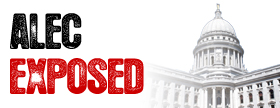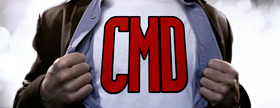"Legitimate Visitors" to U.S. Get the Disney Treatment
 Travelers flying into the United States via airports in Washington DC and Houston are being shown "a sappy seven-minute film made by the folks at Walt Disney showcasing all that is wonderful, scenic and nice about the land of the free." Eventually, the film will be shown "in the international arrivals halls of all major U.S. airports as well as in visa-processing offices around the world. Major airlines will also be encouraged to show it on aircraft shortly before landing in the U.S." The movie was made by Disney's Frederico Tio, himself a Cuban immigrant, and donated to the U.S. government. U.S. public diplomacy czar Karen Hughes praised the film for "creating a warm first impression, and first impressions are important." A joint U.S. government / Disney press release says the film is part of "a joint vision" by the State and Homeland Security Departments "to enhance border security while streamlining security processes and facilitating travel for legitimate visitors."
Travelers flying into the United States via airports in Washington DC and Houston are being shown "a sappy seven-minute film made by the folks at Walt Disney showcasing all that is wonderful, scenic and nice about the land of the free." Eventually, the film will be shown "in the international arrivals halls of all major U.S. airports as well as in visa-processing offices around the world. Major airlines will also be encouraged to show it on aircraft shortly before landing in the U.S." The movie was made by Disney's Frederico Tio, himself a Cuban immigrant, and donated to the U.S. government. U.S. public diplomacy czar Karen Hughes praised the film for "creating a warm first impression, and first impressions are important." A joint U.S. government / Disney press release says the film is part of "a joint vision" by the State and Homeland Security Departments "to enhance border security while streamlining security processes and facilitating travel for legitimate visitors."
- 3892 reads
 Printer-friendly version
Printer-friendly version- Add new comment
- permalink





Comments
Enhance Welcome for Visitors, Say Travel, Tourism Officials
Washington – Potential visitors to the United States need to be told that the visa process has been accelerated and that America wants them to come, Jay Rasulo, the chairman of Walt Disney Parks and Resorts, told a Senate hearing recently.
He commended the U.S. government for improvements such as reducing the time visa seekers must wait for appointments with consular officials, but added, “We must also tell the world we did it -- because negative perceptions have a funny way of lingering long after the reality has changed.”
Since the terrorist attacks on September 11, 2001, travel to the United States has declined 17 percent, resulting in the loss of nearly 200,000 jobs, $94 billion in spending and $16 billion in tax receipts, according to a report, Blueprint to Discover America, submitted to the Senate at the January 31 hearing by a coalition of business leaders. The report makes recommendations for improving the visa process, enhancing security and efficiency at ports of entry and changing the perception that America is unwelcoming to international visitors.
Travel to the United States makes most visitors feel more positively about this nation, said Rasulo, who also chairs the Travel Industry Association and the U.S. Travel and Tourism Advisory Board. “If we can get people though the gate, we can change their perceptions of America,” he told the Senate Committee on Commerce, Science and Transportation.
The U.S. State Department says it has reduced the wait for a temporary business or tourist visa appointment to one week or less at two-thirds of its embassies and consulates. The wait is 30 days or less at fully 90 percent of U.S. embassies and consulates. Students and urgent business travelers receive priority appointments at all posts. Visas are issued within two days of the interview in 97 percent of cases.
These efforts are paying off, according to the State Department. The number of temporary business and tourist visas issued in fiscal year 2006 was up 12 percent over fiscal year 2005, and the number of student/exchange visitor visas increased by 14 percent. The Commerce Department has predicted record arrivals and receipts from international travelers to the United States in 2006. (See related article.)
Rasulo told the January 31 hearing that the Blueprint group conducted research to understand why some people avoid traveling to the United States. “It was very clear to us that confusion and misperceptions about the entry experience are a far bigger deterrent than the processes themselves,” he said.
The private sector Blueprint to Discover American shares the same goals as the joint vision articulated a year ago by Secretary of State Condoleezza Rice and Secretary of Homeland Security Michael Chertoff: to protect the United States better while at the same time welcoming legitimate visitors as warmly as possible. (See related article.)
As part of the Rice-Chertoff vision, the United States has been working to test methods of collecting fingerprints and other data for select groups of applicants to be processed without having to visit an embassy facility and to create a one-stop redress center for travelers who have concerns about their treatment in the screening process.
In August 2006, the Department of State began issuing electronic passports to business and tourist travelers, and as part of the Western Hemisphere Travel Initiative (WHTI), the Department of State has proposed a PASSport card for border community residents. (See related article.)
As part of its commitment to welcome travelers, the State Department has added 570 consular positions worldwide, invested millions in technology and information sharing, and begun posting visa appointment wait times online, according to a State Department fact sheet.
The Department of Homeland Security has established the Consolidated Trusted Traveler Program (CTTP) to integrate all existing and proposed trusted traveler programs for international air, land and sea travel.
On January 23, the United States instituted a requirement that all travelers entering the United States by air, including American citizens, submit a passport or other secure document, which not only will enhance security but also facilitate travel by limiting the number of documents with which border inspectors must be familiar.
As of November 2006, the State Department required all nonimmigrant visa applicants to use the electronic visa application form, which allows consular staff to focus on higher-priority tasks. The Department of State is promising a new online application form by September 2007 that will permit greater screening in advance of the visa interview.
An example of the commitment to improve service was cited by another witness, Jonathan Tisch, chairman and of Loews Hotels: when wait times for visas in India reached as long as six months in November 2006, the State Department committed additional staffing and resources, processing backlogged applications and reducing wait times to less than one week in three of its four consulates. Tisch suggested creating “rapid response teams” that could be sent wherever heavy demand creates such backlogs.
_____________________
Submited by : Bajar Libros
Blame Canada
A follow-up [http://www.nytimes.com/aponline/us/AP-US-Canada.html report by the Associated Press] reveals that some of the Disney video's stirring imagery is actually of Canada:
Wow...
...this is as disturbing as the "video news releases."
I just recently became a conscious adult. Can anyone tell me what is going on?
I don't really think it's disturbing so much as pathetic.
If some more people from abroad go to see the Grand Canyon as a result of this film, so much the better. And there's no law that a WELCOME mat must also say, "This house is really squalid on the inside." In that way, this isn't the same issue as VNRs.
Propagandists generally tend to have an exaggerated idea of how effective their work is. The point Hughes seems to miss is that for most people entering the country, even for the first time, it's probably too late to make that "first impression."
But suppose she really wanted to make this a "fair and balanced" offering -- along with the feel-good stuff, the film ought to show, say, cops teargassing reporters and protesters at pro-immigrant demonstrations.
It would be easy...
...to seize upon those words "joint vision" and joke that the stuff out there really is getting stronger, but the real menace is in the clause "to enhance border security while streamlining security processes." That means they hook you up to a polygraph while showing you the film. If the polygraph shows reactions consistent with nausea, you get shipped to Gitmo.